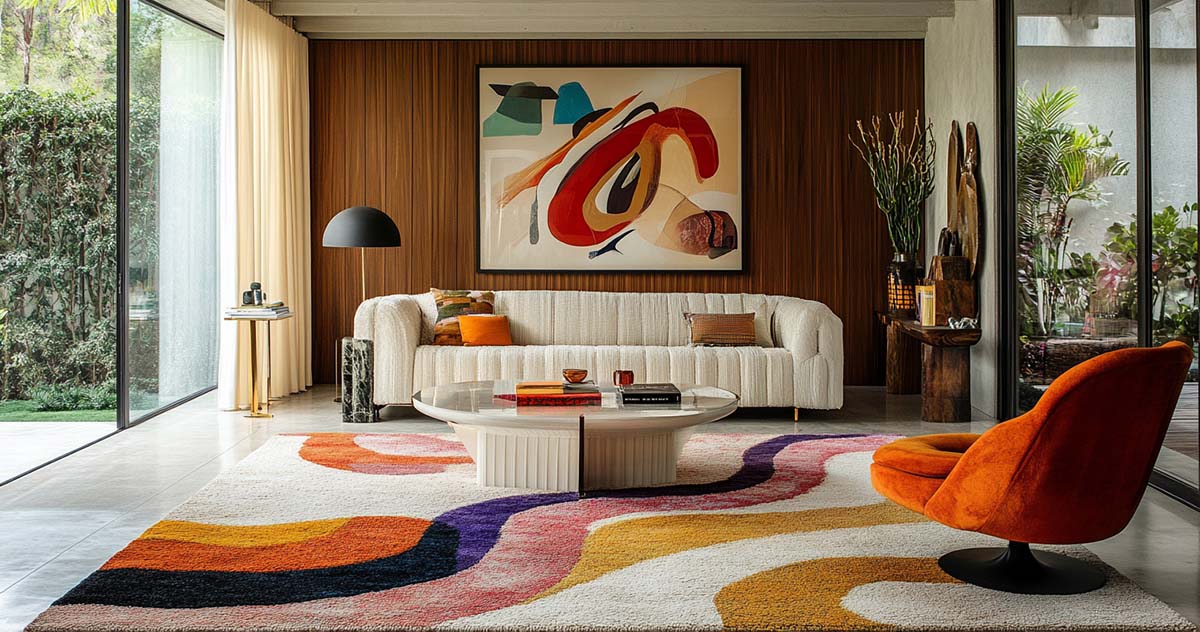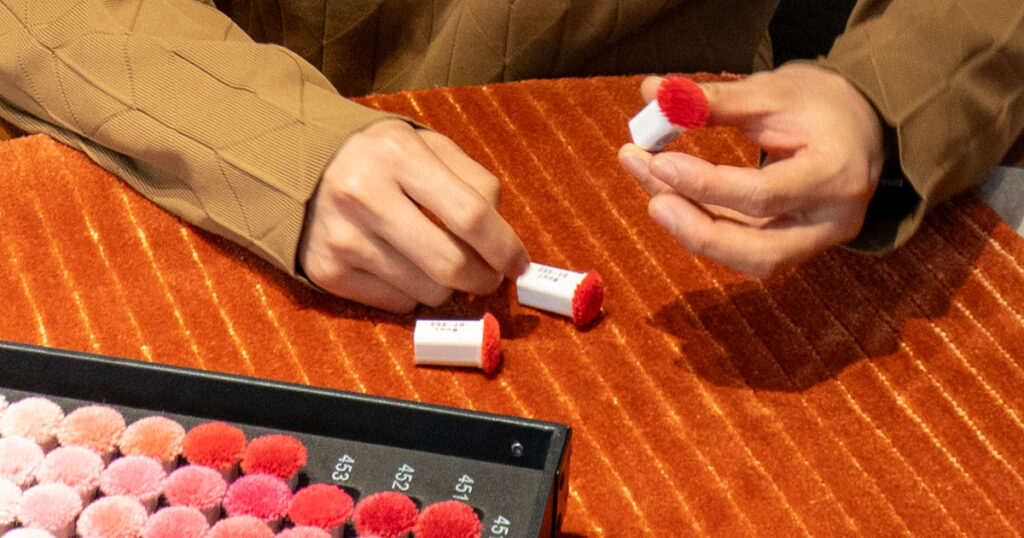This guide unveils the timeless charm of mid-century modern rug designs.
Discover the key elements that define this iconic style.
Explore color palettes and patterns that capture the essence of mid-century modern aesthetics.
Get practical tips on styling and caring for these statement pieces.
Ready to transform your home with mid-century flair?
Let’s dive in.
Introduction
Mid-century modern design, spanning from the mid-1940s to the late 1960s, continues to captivate interior designers and homeowners with its simplicity, functionality, and timeless aesthetic.
In this comprehensive guide, we’ll explore the world of mid-century modern rug designs, focusing on their history, key characteristics, and how to incorporate them into your home.
What are Mid-Century Modern Rugs?
Mid-century modern rugs are floor coverings that embody the design principles of the mid-20th century.
- These rugs often feature clean lines, geometric patterns, organic shapes, and a mix of natural and synthetic materials.
- They serve as a foundation for the iconic furniture pieces of the era, such as the Eames lounge chair or the Noguchi coffee table, while also adding warmth, texture, and color to a room.
Why Mid-Century Modern Rugs are Popular Today
- eless Appeal: The clean lines and simple yet striking designs of mid-century modern rugs have a timeless quality that continues to resonate with people today.
- Versatility: These rugs can complement a wide range of interior styles, from contemporary to bohemian, making them adaptable to various decor preferences.
- Nostalgia and Retro Trend: The resurgence of interest in vintage and retro styles has contributed to the popularity of mid-century modern design, including rugs.
- Quality and Craftsmanship: Many original mid-century modern rugs were crafted with attention to detail and high-quality materials, making them durable and desirable.
Key Elements of Mid-Century Modern Rug Design
- Geometric Patterns: Bold geometric shapes, such as circles, triangles, and diamonds, are a hallmark of mid-century modern rug design.
- Abstract Designs: Rugs featuring abstract compositions and asymmetrical patterns reflect the artistic innovations of the era.
- Clean Lines: Simple, uncluttered designs with minimal ornamentation characterize mid-century modern rugs.
- Organic Shapes: Curved lines and organic forms, inspired by nature, are also common in mid-century modern rug designs.
- Natural Materials: Wool, cotton, and jute are frequently used in mid-century modern rugs, adding texture and warmth.
- Synthetic Materials: In line with the era’s embrace of new technologies, synthetic materials like nylon and polyester are also used.
Mid-Century Modern Rugs vs. Contemporary Rugs
While mid-century modern rugs share some similarities with contemporary designs, such as clean lines and geometric patterns, there are key differences:
- Color Palette: Mid-century modern rugs often feature bold, saturated colors like deep oranges, teals, and mustard yellows, while contemporary rugs tend to favor more neutral or muted tones.
- Materials: Contemporary rugs may incorporate a wider range of materials, including more synthetic options, while mid-century modern rugs often prioritize natural fibers.
- Retro Aesthetic: Mid-century modern rugs have a distinctly retro feel that sets them apart from contemporary designs, which tend to have a more modern or minimalist look.
Choosing the Right Size and Shape
When selecting a mid-century modern rug, consider the size and layout of your room, as well as the placement of furniture:
- Living Room: For a living room, choose a rug large enough to anchor the seating area, with the front legs of sofas and chairs on the rug.
- Dining Room: In a dining room, select a rug that extends at least 24 inches beyond the edges of the table to allow space for chairs to be pulled out.
- Bedroom: For a bedroom, a rug should be large enough to extend beyond the sides and foot of the bed, or use smaller rugs on either side of the bed.
- Shape: Rectangular rugs are the most common, but square and round options can work well in certain spaces, such as under a circular dining table.
Materials Used in Mid-Century Modern Rugs
- Wool: Durable, soft, and naturally stain-resistant, wool is a popular choice for mid-century modern rugs.
- Cotton: Cotton rugs are lightweight, easy to clean, and often more affordable than wool.
- Jute: Jute adds a natural, textural element to mid-century modern spaces and is often used in rugs with a more casual or bohemian feel.
- Nylon and Polyester: Synthetic materials offer durability and stain-resistance, making them a practical choice for high-traffic areas.
Color Palettes for Mid-Century Modern Spaces
- Earthy Tones: Warm, earthy colors like mustard yellow, olive green, and burnt orange are quintessential mid-century modern hues.
- Vibrant Accents: Bold, saturated colors such as teal, turquoise, and bright red can be used as accents to add visual interest and energy to a space.
- Neutral Foundations: Neutral colors like gray, beige, and cream can provide a subtle foundation that allows furniture and decor to take center stage.
Incorporating Patterns and Textures
- Geometric Designs: Incorporate rugs with geometric patterns, such as diamonds, triangles, and chevrons, to add a dynamic and visually appealing element.
- Abstract Motifs: Rugs with abstract designs and asymmetrical compositions can bring an artistic flair to a mid-century modern space.
- Textural Elements: Use rugs with varied textures, such as shag or woven jute, to add depth and dimension to a room.
Styling Mid-Century Modern Rugs in Your Home
- Living Room: Pair a boldly patterned rug with iconic mid-century furniture pieces, like an Eames lounge chair or a low-profile sofa.
- Dining Room: Use a solid-colored or subtly patterned rug to anchor a dining table and chairs, allowing the furniture to be the focal point.
- Bedroom: Create a cozy and inviting atmosphere with a plush, textural rug in warm, earthy tones.
- Layering: Experiment with layering rugs of different sizes, colors, and textures to add visual interest and depth to a space.
Caring for Your Mid-Century Modern Rug
- Vacuum Regularly: To maintain the appearance and longevity of your rug, vacuum it regularly to remove dirt and debris.
- Spot Clean Spills: Address spills and stains promptly by blotting (not rubbing) with a clean, damp cloth and mild detergent.
- Professional Cleaning: Have your rug professionally cleaned every 1-2 years, or more frequently for high-traffic areas.
- Rotate Occasionally: To ensure even wear, rotate your rug every 6-12 months, especially in areas with heavy foot traffic.
Where to Shop for Mid-Century Modern Rugs
- Vintage and Antique Stores: Search for authentic mid-century modern rugs at vintage and antique shops, both in-person and online.
- Specialty Retailers: Look for retailers that specialize in mid-century modern design, as they often have a curated selection of rugs in this style.
- Online Marketplaces: Explore online marketplaces like Etsy, eBay, and 1stDibs for a wide variety of mid-century modern rugs, including both vintage and reproduction options.
- Custom and Made-to-Order: Consider commissioning a custom rug inspired by mid-century modern design principles for a one-of-a-kind piece tailored to your space.
Mid-Century Modern Rug Buying Tips
- Set a Budget: Determine your budget before shopping to narrow down your options and avoid overspending.
- Consider Your Lifestyle: Think about your daily routines and the level of foot traffic in each room to choose a rug that will withstand your lifestyle.
- Order Samples: If possible, request samples of rugs you’re considering to see the colors, textures, and materials in person before making a purchase.
- Read Reviews: When shopping online, read customer reviews to get insights into the quality, durability, and appearance of a rug before buying.
Conclusion
Mid-century modern rug designs offer a timeless and versatile way to infuse your home with the iconic style of the mid-20th century.
By understanding the key characteristics, materials, colors, and patterns of this enduring design movement, you can confidently select the perfect rug to complement your space.
With this comprehensive guide, you now have the knowledge and tools to create a space that celebrates the enduring appeal of this timeless style.




